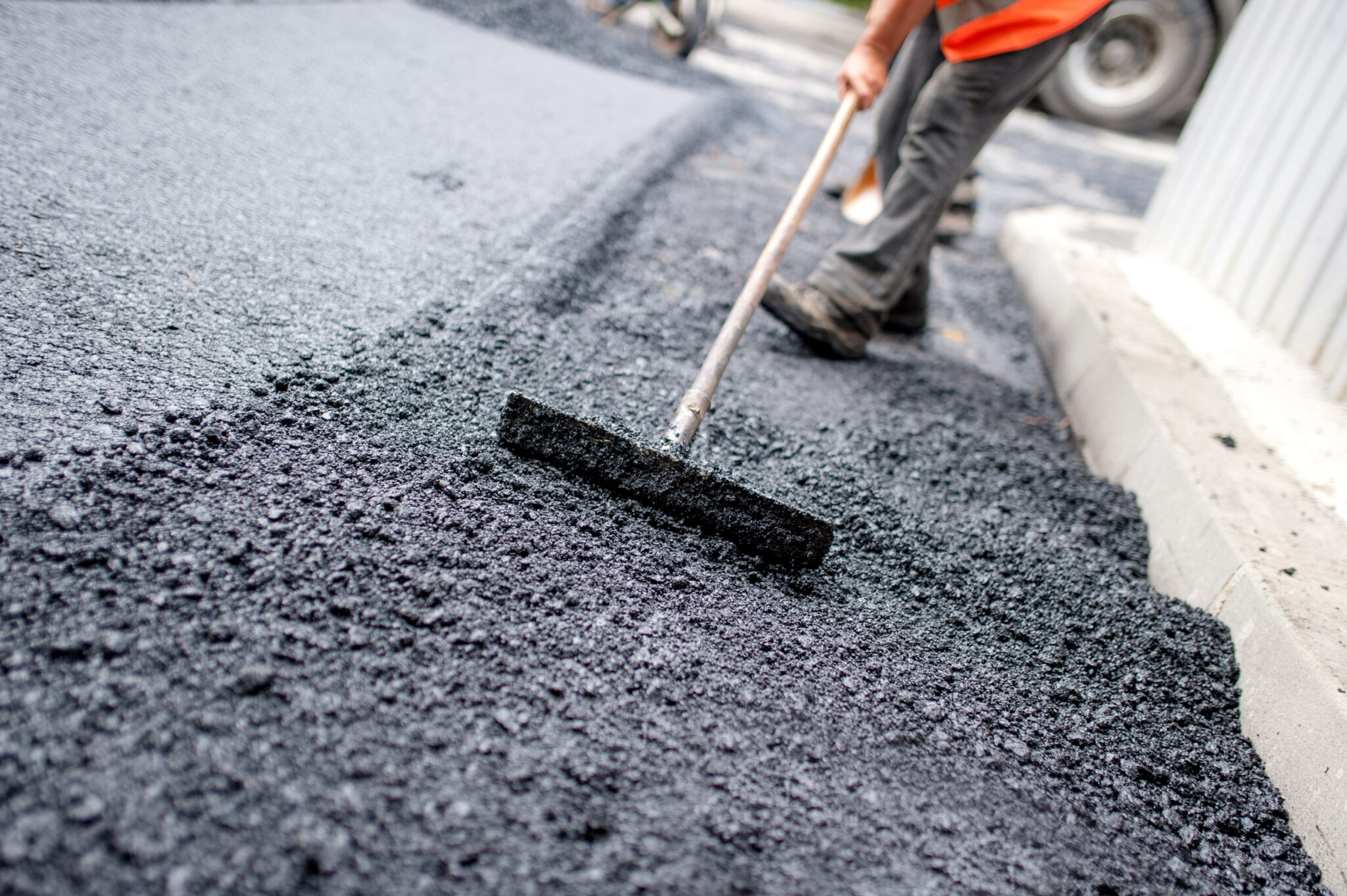You’ve probably heard the terms “bitumen” and “asphalt” thrown around quite a bit. They’re often used interchangeably, but did you know they’re not actually the same thing? Understanding the difference between bitumen and asphalt can save you time, money, and hassle when planning your next paving project. Whether you’re resurfacing a driveway, building a new road, or maintaining a parking lot, choosing the right material is extremely important. In this blog, we’ll break down what bitumen and asphalt are, how they’re produced, and how they differ in composition, application, and cost.
What is Bitumen?
Bitumen is a black, sticky, and dense form of petroleum that can be semi-solid or liquid. It can be found naturally in deposits like the Pitch Lake in Trinidad. Still, most of the bitumen used today is produced through crude oil distillation in modern refineries. First, lighter fractions like gasoline and diesel are extracted from the crude oil, using boiling points to separate them. Then, the thick residue left behind is processed into bitumen. Although it’s the leftover gunk from crude oil distillation, bitumen is essential in the construction world, acting as the glue that holds much of our pavement and buildings together.
How is Bitumen Made?
As we mentioned earlier, bitumen is the byproduct of heating crude oil and separating its components. In some cases, bitumen is further treated through air blowing or polymer modification. Air blowing helps increase stiffness and resistance to temperature changes, while polymer modification adds elasticity, which is especially useful for demanding applications like bridge decks and high-performance roofing. These additional treatment methods improve bitumen’s lifespan and adaptability to extreme environments.
Properties of Bitumen:
- Adhesive: Binds aggregate material together, which is necessary for asphalt pavement surfacing.
- Water-resistant: Forms a barrier against moisture, preventing damage to structures.
- Flexible (within limits): Becomes soft and workable when heated, allowing it to be molded or applied as needed.
Applications of Bitumen:
Bitumen is often used as a binder in asphalt mixtures, but it has several lesser-known applications as well, such as:
- Roofing felt and shingles in both residential and commercial buildings
- Waterproofing membranes for basements and foundations
- Protective coatings for pipelines, bridge decks, and structural steel
- Sealants and joint fillers to prevent cracking and water ingress in concrete
Bitumen’s wide range of uses makes it one of the most versatile materials in construction. Now that you’ve got the gist of bitumen’s process, properties, and applications, we’ll go over what makes asphalt unique.
What is Unique About Asphalt?
Asphalt is not a raw material, but a composite. It’s made by mixing bitumen (as a binder) with aggregates like crushed stone, sand, and gravel. This mixture is heated and laid while hot, then compacted to form a durable surface.
Types of Asphalt:
There are a few variations of asphalt specifically tailored for certain environments and performance needs. Some of these include:
- Hot Mix Asphalt (HMA): Used for highways and large-scale paving jobs. It’s laid while piping hot for durable compaction.
- Warm Mix Asphalt (WMA): Can be laid at lower temperatures than HMA. It’s more environmentally friendly.
- Cold Mix Asphalt (CMA): Used mainly for patching and temporary repairs. It doesn’t require heating before application.
- Porous Asphalt: Designed to allow water to drain through, reducing runoff and improving groundwater recharge.
Applications of Asphalt:
Asphalt has many infrastructural uses for both commercial and residential purposes. Here’s a handful of common applications:
- Roadways and highways
- Driveways and parking lots
- Airport runways
- Bike paths and walking trails
Because asphalt combines the strength of stone with the adhesive properties of bitumen, it’s the standard for paved surfaces that endure heavy traffic and environmental stress. In the next section, we’ll compare asphalt and bitumen side by side to highlight their differences.
Bitumen vs Asphalt: Key Differences
Bitumen makes up about 5-10% of asphalt, but individually, they’re separate substances. Below, we’ve compiled a brief table showing their key distinctions:
| Category | Bitumen | Asphalt |
| Composition | Sticky, black petroleum product used to hold aggregates together. | A mixture of bitumen and aggregates. |
| Form and Use | Liquid or semi-solid. Applied in thin layers as a waterproof coating, sealant, or adhesive. | Comes as a mixture. Applied in thick, load-bearing layers for paving. |
| Application | Heated and applied with sprayers, rollers, or brushes. | Heated, mixed, spread, and compacted using paving equipment. |
| Function | Provides waterproofing, adhesion, and protection. | Provides structural integrity and wear resistance for high-traffic surfaces. |
| Durability | Not ideal for heavy loads; too soft or brittle depending on temperature. | Built for durability, withstands traffic and temperature changes effectively. |
| Cost | Generally cheaper per unit, but limited in its applications. | More expensive per ton, but necessary for structural paving applications. |
By now, you probably have a good idea of the relationship between asphalt and bitumen and how they differ. Next, we’ll go over how to choose the best material for your specific needs.
Choosing Between Bitumen and Asphalt for Your Project
If you’re deciding which material to use, you’ll need to consider the type of project, environmental conditions, budget, and expected wear over time.
Bitumen Is Ideal When:
- You need a sealing layer to waterproof a surface.
- You’re working on roofing, basement membranes, or pipe protection.
- The surface won’t be exposed to vehicle traffic or heavy loading.
Bitumen excels in moisture resistance and adhesion but isn’t designed to handle weight or movement. It’s a supporting player in large infrastructure jobs.
Asphalt Is Better When:
- You need a durable, traffic-ready surface.
- The surface will face frequent loading, like from vehicles or machinery.
- You want a long-lasting finish that can handle environmental changes.
Asphalt is the complete package—binding, structure, and resilience all in one material. It’s the smart choice for any project involving roads, driveways, or high-use paved areas.
Other Considerations:
- Climate Adaptability: Asphalt can be tailored to suit hot, cold, or wet climates through additives and mix design. Bitumen alone is more temperature-sensitive.
- Maintenance: Asphalt surfaces benefit from bitumen-based sealcoating to preserve their lifespan and prevent oxidation.
- Sustainability: Asphalt is one of the most recycled materials in construction. Old asphalt can be ground up, reheated, and reused with new bitumen. Using recycled asphalt lowers costs and reduces landfill waste.
If you’re looking for a good sealant, bitumen is the way to go. However, if you need long-term performance, asphalt is your go-to, especially when paired with preventative maintenance.
Need Asphalt Maintenance Help? Contact Superior Asphalt
When choosing between the two, it really depends on your specific needs. If you’re looking for a durable, smooth surface for a road or parking lot, asphalt is the way to go. On the other hand, bitumen is more commonly used as a binder or sealant in various construction applications. Still not sure which one is right for your project? At Superior Asphalt, we offer high-quality maintenance and repair services for crushed asphalt, helping you keep your surfaces looking like new. Whether it’s addressing small issues before they become big problems or being proactive with preventative maintenance, our team of experts has you covered. Get in touch with us today!


